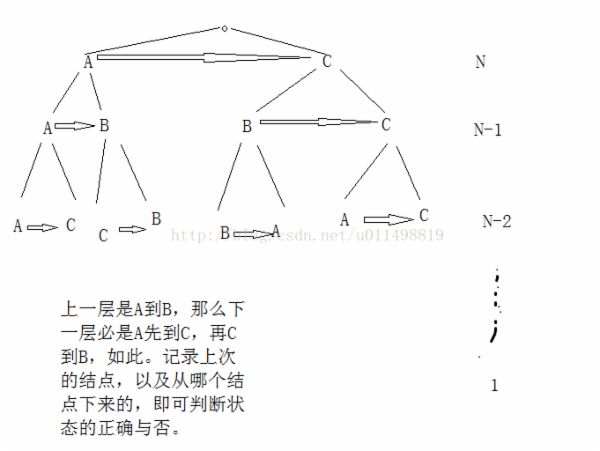暑假集训第二周——递推 汉诺塔系列问题
/先说汉若塔I(经典汉若塔问题),有三塔,A塔从小到大从上至下放有N个盘子,现在要搬到目标C上,
规则小的必需放在大的上面,每次搬一个,求最小步数。这个问题简单,DP:a[n]=a[n-1]+1+a[n-1],先把
上面的n-1个放在B上,把最大的放在目标C上,再把N-1个放回到C上即可
Description
Gardon是个怕麻烦的人(恩,就是爱偷懒的人),很显然将64个圆盘逐一搬动直到所有的盘子都到达第三个柱子上很困难,所以Gardon决定作个小弊,他又找来了一根一模一样的柱子,通过这个柱子来更快的把所有的盘子移到第三个柱子上。下面的问题就是:当Gardon在一次游戏中使用了N个盘子时,他需要多少次移动才能把他们都移到第三个柱子上?很显然,在没有第四个柱子时,问题的解是2^N-1,但现在有了这个柱子的帮助,又该是多少呢?
Input
Output
Sample Input
Sample Output
动态规划,转移是
g[n]=min{g[n-k]+g[n-k]+f[k]}(1<=k
f[n]=f[n-1]+f[n-1]+1;----->f[n]=2^n-1;
1 2 3 4 5 6 7 8 9 10 11 12 13 14 15 16 17 18
#include汉若塔III hdu2064
Description
现在我们改变游戏的玩法,不允许直接从最左(右)边移到最右(左)边(每次移动一定是移到中间杆或从中间移出),也不允许大盘放到下盘的上面。
Daisy已经做过原来的汉诺塔问题和汉诺塔II,但碰到这个问题时,她想了很久都不能解决,现在请你帮助她。现在有N个圆盘,她至少多少次移动才能把这些圆盘从最左边移到最右边?
Input
Output
Sample Input
Sample Output
在经典汉若塔问题的条件改为,每次只能移动到附近塔上,求把A塔所有的移动C塔最小次数。
a[n]=a[n-1]+1+a[n-1]+1+a[n-1]:先把上面的N-1个移动到C(必然有这个状态),在把最大的移到B,再把N-1移到到A,把最大的移到C,再把N-1个移到C。
1 2 3 4 5 6 7 8 9 10 11 12 13 14 15 16 17 18
#include汉若塔IV HDU 2077
Description
Input
每组数据有一个正整数n(1 <= n <= 20),表示有n个盘子。
Output
Sample Input
Sample Output
分析:
A,B,C三个塔,方程:a[n]=ab[n-1]+1+1+bc[n-1]. (ab表示a到b)
DP思路:先把n-1个搬到b,再用俩步般最大的到C,再把n-1个从B到C。这里又要求出ac[n]和bc[n]:求其递推方程:bc[n]=bc[n-1]+1+ac[n-1],
会发现bc[]方程和ab[n]一样的。所以总方程a[n]=2*ab[n-1]+2.
1 2 3 4 5 6 7 8 9 10 11 12 13 14 15 16 17 18 19 20 21 22 23 24
#includeDescription
发生错移产生的系列就增加了,这种错误是放错了柱子,并不会把大盘放到小盘上,即各柱
子从下往上的大小仍保持如下关系 :
n=m+p+q
a1>a2>...>am
b1>b2>...>bp
c1>c2>...>cq
计算所有会产生的系列总数.
Input
目N<30.
Output
Sample Input
Sample Output
1 2 3 4 5 6 7 8 9 10 11 12 13 14 15 16
#include汉若塔VI HDU1995
在经典汉若塔问题上附加问题:求出N个盘子时,第K号盘子的移动次数。
思路,一想就是二维DP,DP[n][i]=dp[n-1][i]*2(1= 最大盘只移动一次,上面盘子先移到B塔,一次,最后由B到目标C又一次,思路清晰,分分钟KO。
#include {
dp[i][j]=2*dp[i-1][j];
}
dp[i][i]=1;
}
int t;
int n,m;
cin>>t;
while(t--)
{
cin>>n>>m;
cout< }
return 0;
} 汉若塔VII HDU1996
在经典汉若塔问题上,求一共有多少个状态(包括所有可能移到到的状态),一个排列组合问题,
答案:求和( C(k1,n)*C(k2,n-k1))其中n>=k1>=0,n-k1>=K2>=0,从中挑出K1个从小到大放在A塔,再从剩下的
挑出K2个放在B塔,剩余的放在C塔即可。数据非大数。
其他巧妙方法:每个盘从小到大每个都有3种选择,共3^n。
#include }
return 0;
} 汉诺塔VII hdu1997 在经典汉若塔问题上,给出任意一个状态(移到过程中),判断该状态是否在正确的(最小移到情况)状态
中。
思路:做到这题,汉若塔就很清晰了,有几步、几个状态、状态的正确性、每个盘子的移到情况,都了如指掌。说说该题思路:
n号塔必然是A->C,那么N-1号塔, 若n在A,则n-1 在A或B,
见图:
#include {
cin>>tx;get[tx]='A';
}
cin>>p;
for(int i=0;i {
cin>>tx;get[tx]='B';
}
cin>>q;
for(int i=0;i {
cin>>tx;get[tx]='C';
}
tf=1;
over=0;
if(get[n]=='B')
{
cout<<"false"<continue;
}
dfs('A','C',get[n],n);
if(tf==1)cout<<"true"< else cout<<"false"< }
return 0;
} 